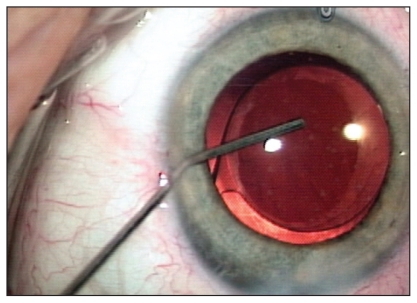Cataract surgery is one of the most common surgical procedures performed in Canada and worldwide
More than 9.5 million cataract surgeries are performed worldwide each year.1 The number of procedures has more than doubled between 1992 and 2004 in the province of Ontario.2 Through a small incision (< 3.0 mm), a phacoemulsification probe that oscillates at ultrasonic speeds breaks up and removes the opaque cataract lens, and a permanent artificial lens is inserted into the original capsule that held the cataract.
Serious postoperative complications are uncommon
Serious complications from cataract surgery include retinal detachment (0.8%) and endophthalmitis (0.1%) (Figure 1).3,4 Posterior capsular opacification, a more common postoperative condition (4.2% within 90 days), results from the proliferation and migration of retained lens epithelial cells across the posterior capsule and can be easily treated with a laser to create a clear aperture in the visual axis.3
Figure 1:
Injection of prophylactic antibiotic to reduce the risk of postoperative infection and to inflate the eye to a normal intraocular pressure. The artificial intraocular lens is seen beneath the surgical instrument.
Patients require glasses for near vision after standard cataract surgery
Traditional artificial intraocular lenses, now usually made of acrylic polymers, cannot change shape to allow for clear vision at different distances like a young human lens can.
One way to eliminate the need for glasses is to use multifocal intraocular lenses
Multifocal intraocular lenses simultaneously focus images of targets located at different distances from the eye, allowing the brain to choose the best focused image from each eye. Although patients are generally satisfied with these lenses, some may be intolerant of the haloes, glare and reduced contrast sensitivity associated with them.5
Another way to eliminate the need for glasses is monovision, whereby the power of the intraocular lens is chosen to enable midrange or near vision in one eye and distance vision in the other eye
After a period of adaptation, which can take several weeks, the brain learns to select the clearest central image from one eye at a particular distance and suppress the image from the other eye. Because there may be some loss of three-dimensional stereo vision with this approach, it may not be suitable for all patients.6
Footnotes
Competing interests: Steve Arshinoff has received consultancy fees from ArcticDx and Alcon Laboratories. No competing interests declared by Jonathan Micieli.
This article has been peer reviewed.
References
- 1.Foster A. Vision 2020: the cataract challenge. Community Eye Health 2000;13:17–9 [PMC free article] [PubMed] [Google Scholar]
- 2.Rachmiel R, Trope GE, Chipman ML, et al. Cataract surgery rates in Ontario, Canada, from 1992 to 2004: more surgeries with fewer ophthalmologists. Can J Ophthalmol 2007;42:539–42 [PubMed] [Google Scholar]
- 3.Greenberg PB, Tseng VL, Wu WC, et al. Prevalence and predictors of ocular complications associated with cataract surgery in United States veterans. Ophthalmology 2011;118:507–14 [DOI] [PubMed] [Google Scholar]
- 4.Taban M, Behrens A, Newcomb RL, et al. Acute endophthalmitis following cataract surgery: a systematic review of the literature. Arch Ophthalmol 2005;123:613–20 [DOI] [PubMed] [Google Scholar]
- 5.Leyland M, Pringle E. Multifocal versus mono-focal intraocular lenses after cataract extraction. Cochrane Database Syst Rev 2006;(4)CD003169. [DOI] [PubMed] [Google Scholar]
- 6.Finkelman YM, Ng JQ, Barrett GD. Patient satisfaction and visual function after pseudophakic monovision. J Cataract Refract Surg 2009;35:998–1002 [DOI] [PubMed] [Google Scholar]



